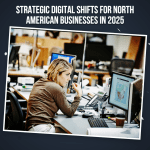In 2025, the payment process has moved beyond transactional functionality. It is now a core component of customer experience, operational efficiency, and competitive strategy. With nearly 87 percent of consumers demanding seamless checkout experiences and 63 percent abandoning carts when friction arises, the imperative is clear: businesses must simplify payments without compromising compliance or security.
For organizations operating across the United States and Canada, the stakes are even higher. Evolving technologies, divergent regional regulations, and rapidly changing consumer expectations require a modernized, secure, and adaptive payment ecosystem.
This report outlines the most impactful developments in digital payments, the technologies leading operational transformation, and the strategic imperatives for enterprise resilience.
Part 1: Understanding the 2025 Digital Payment Imperative
Consumer Behavior as a Strategic Catalyst:
New data from PYMNTS underscores the need for businesses to align payment infrastructure with shifting consumer behavior:
- Digital Wallet Usage: Digital wallets now account for 36.7 percent of US online transactions, surpassing credit cards, which have declined by 6.2 percent since 2022.
- Contactless Payments in Canada: Tap-to-pay usage has surged by 214 percent since the national rollout of Interac Flash. Nearly 78 percent of transactions under 100 Canadian dollars are now contactless.
- Buy Now, Pay Later (BNPL): BNPL services are no longer confined to discretionary purchases. They now penetrate 42 percent of utility and healthcare payments.
These data points reflect a paradigm shift toward flexible, secure, and intuitive payment pathways. Enterprises that fail to accommodate this shift risk losing consumer trust and revenue.
Part 2: Key Technologies Reshaping Transactional Strategy
Artificial Intelligence and Real-Time Fraud Mitigation:
Deloitte’s 2025 security brief identifies neural network-based fraud detection as the standard for high-volume digital merchants. Solutions like Stripe Radar analyze over two million data points per transaction and recalibrate risk models in under 200 milliseconds. Businesses using these systems experience a 58 percent reduction in false positives and up to 99.3 percent threat detection rates.
Strategic Recommendation: Pair AI-driven platforms with post-quantum encryption standards, such as the NIST-approved CRYSTALS-Kyber framework, to ensure both agility and regulatory compliance.

Unified Commerce Platforms: Streamlining the Payment Stack:
Integrated Software Vendors (ISVs) such as Square, Shopify, and Lightspeed now offer fully unified platforms that combine:
- Point-of-sale and e-commerce payment processing.
- CRM and inventory management.
- Tax reporting and reconciliation.
Adoption of these systems can reduce reconciliation errors by up to 73 percent and save small to midsized businesses an average of $18,000 per year in administrative costs.
Executive Insight: For cross-border operations, investing in modular yet unified systems minimizes operational fragmentation and accelerates go-to-market execution.
Part 3: Regional Realities Contrasting the US and Canadian Markets
The United States: Fragmented Terminals and Loyalty-Driven Consumers
While 70 percent of US peer-to-peer transactions utilize mobile apps like Venmo or Cash App, only 17 percent of in-store payments are mobile wallet-based. This discrepancy stems from two primary challenges:
- Hardware Limitations: 41 percent of US terminals still do not support NFC (tap-to-pay).
- Loyalty Preferences: A majority of consumers prefer using credit cards to accrue loyalty points, even when more convenient payment options are available.
Actionable Strategy: Implement hybrid payment terminals capable of processing magstripe, chip, and contactless transactions. Additionally, enable dynamic rewards routing to align with consumer incentives.

Canada: Innovation through Real-Time Rails and Interac Leadership
Canada’s payment ecosystem has experienced a structural transformation through real-time rails (RTR) and Interac e-Transfer expansion. Key capabilities include:
- Instantaneous bill payments within 1.5 seconds.
- Government payments delivered directly to mobile wallets.
- AI-powered remittance matching to automate reconciliation.
Processors like Moneris and TD Merchant Services now offer Dynamic Currency Conversion at a 0.5 percent markup significantly lower than the industry-standard 3.5 percent. Their APIs also support batch reconciliation across Interac, Mastercard, and Visa transactions.
Operational Note: Businesses that transact in both currencies should prioritize partnerships with institutions offering DCC and AI-integrated APIs to maintain cost predictability.
Also Read: AI tools for business growth
Part 4: Sector-Specific Payment Models:
Retail: Optimizing Checkout through “Phygital” Integration
Retailers such as Best Buy Canada are pioneering “phygital” checkout models, merging physical and digital experience layers. Their 2025 model includes:
- Scan-and-Go: Mobile app scanning replaces traditional checkout lanes.
- Biometric Security: Palm vein recognition authorizes in-store payments.
- Split Tender Logic: Automated BNPL, credit, or cryptocurrency allocation at point-of-sale.
These updates have increased basket sizes by 23 percent and reduced average checkout time to 19 seconds.
B2B Transactions: Embedded Finance and Automation
SAP Ariba and similar platforms now enable fully embedded finance environments with:
- Dynamic discounting driven by real-time cash flow.
- Smart contract enforcement via blockchain.
- Automated accounts receivable matching with 99.4 percent accuracy.
Strategic Advantage: These capabilities allow B2B enterprises to gain financing flexibility while meeting regulatory and ESG reporting mandates.
Part 5: Building a Resilient, Post-Quantum Security Framework
Zero-trust architecture is now considered essential for any organization handling financial data. Key components include:
- Tokenization: Replaces over 90 percent of card data with secure, PCI-certified tokens.
- Behavioral Biometrics: Real-time anomaly detection based on user input patterns.
- Decentralized Identity: Verifies identity using blockchain credentials.
New regulatory standards, such as the FTC’s 2025 Safeguards Rule, now require all financial systems to implement multi-factor authentication.
Part 6: Preparing for 2026 and Beyond
Enterprises planning for the future should align their payment strategies with three near-term innovations:
- Central Bank Digital Currency (CBDC) Readiness: Pilot programs like Canada’s Jasper V will enable real-time cross-border settlements.
- Voice-Activated Commerce: Optimize checkout flows for voice-enabled devices as adoption increases.
- Augmented Reality Transactions: Tools such as Snapchat’s Camera Kit will integrate directly with e-commerce for AR-based shopping experiences.
Executive Planning Tip: These technologies require cross-functional coordination across IT, finance, and marketing teams. Begin internal assessments now to avoid implementation bottlenecks.
Conclusion: The Strategic Value of Seamless Payments
The payment experience is no longer peripheral; it is pivotal. In 2025, businesses that succeed will not be those that adopt every emerging trend. Instead, they will strategically architect their payment systems to align with:
- Evolving consumer expectations.
- Regional regulatory demands.
- Operational agility and risk mitigation.
As Stripe’s annual report aptly stated, “The payment is not the product, it is the gateway to everything else.”
Organizations that treat this gateway as a strategic asset, rather than a transactional endpoint, will unlock sustainable advantages in revenue performance, customer loyalty, and digital transformation readiness.









